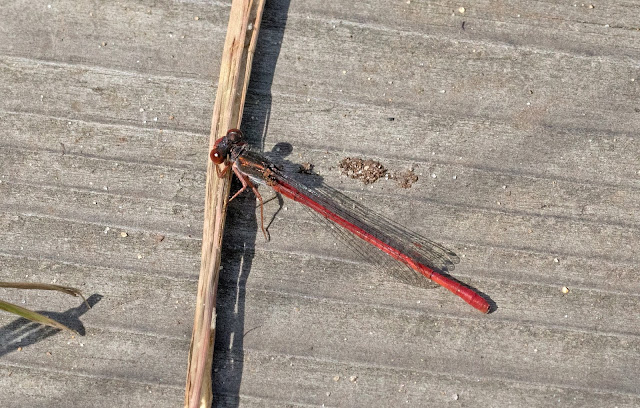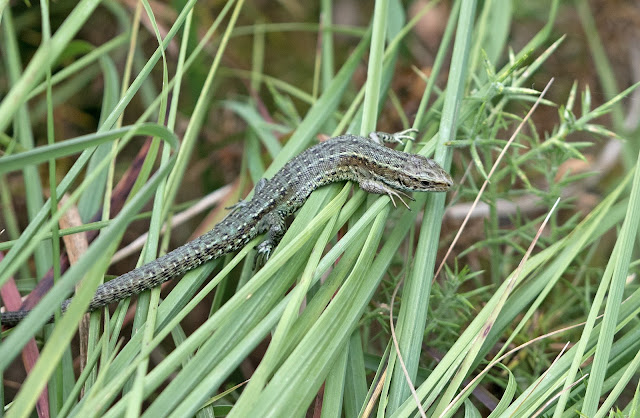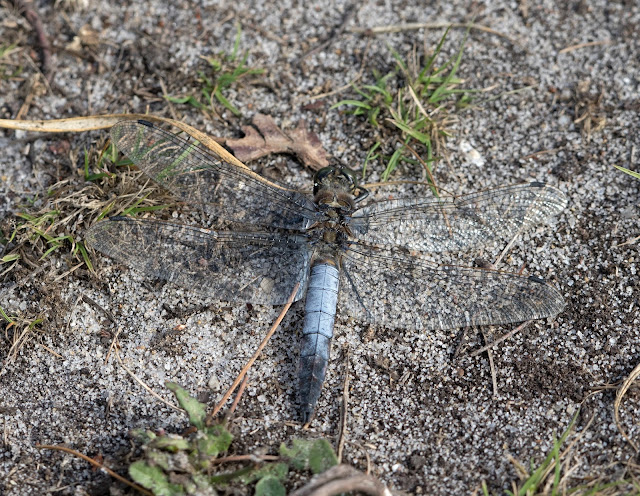When there are lots of postings of Brown Hairstreaks on the web it means that the butterfly season is ending and it is time to resume birding. So, today I did. Martin picked me up and we made for our trusted venue - Breech Pool on the North Wall at Pagham. It was really nice to see the pool looking as it should - a balance of mud and water - rather than the dusty desert that it had become earlier in the year. Plenty of birds too - good numbers of Lapwings and Black-tailed Godwits, several Snipe plus the usual mix of waterfowl.
Peter was in attendance and he had seen what he thought was a Little Stint but it had subsequently disappeared round the back of the pool. I managed to locate a Ruff in with a flock of Redshanks but alas no LS. Then a bird appeared on the mud at the eastern end of the pool and we were on it like a flash, neither of us considered that it was anything other than the aforementioned Little Stint. Later analysis and reports from other birders confirmed that we had been a tad hasty and that it was in fact a Pectoral Sandpiper. Seasoned birders will wonder how one can make such a mistake - well with small shorebirds I find it incredibly easy - best practice is to take as many shots as possible and perform hindsight analysis at home. Another 20 years of birding and I might get the hang of it - problem is I will need someone to push the wheelchair.
The bird was then joined by a cracking Ruff, beautiful plumage and colour, unfortunately the sun refused to shine and all my photographs lacked that much required feather detail. Still the Pec was a new one for me and it is good to be out birding again.
Another record today - at the back of the pool a colour ringed Black-tailed Godwit was roosting with a few of his companions, I try to record these birds when I find them and send off a sighting report with an accompanying photograph. Today was no different except that I sent the report to José Alves who rings birds on the Tagus estuary in Portugal. I received a detailed reply in 12 minutes!!
OG(flag) + OB was ringed as an adult male on 4.02.12 at Seixal Tank, Tagus Estuary, Setúbal, W Portugal and there have been 12 subsequent sightings in Holland, Belgium. Portugal and the UK.
Hello and welcome to my Blog. Mainly I capture photographic records of my birding and butterfly visits to places in the Sussex, Hampshire and Kent countryside. I also have a fascination for all things natural, photographs of which, from time to time, I add to the Blog.
Tuesday, 18 August 2015
Monday, 17 August 2015
Black Darter and Keeled Skimmer
Having been laid low by a summer bug I was left bereft of energy, I just couldn't face lugging the gear up and over the South Downs so I opted for a day on the flat. I kicked off at Stopham Bridge in the hope of a dragonfly or two - nothing doing whatsoever. In a bit of a dilemma I finally decided to give Thursley Common a go - at least the boardwalk is flat. As I parked up I was starting to regret even going out but as soon as I got my sights on a dragon I was away. I finished a short stay with three "life" ticks - Black Darter, Keeled Skimmer and Small Red Damselfly. Also on the wing were Emperors, Southern Hawkers, Brown Hawkers, sundry Blue Damsels, Black-tailed Skimmer, Common Darter and Emerald Damselfly.
A Bog Bush Cricket
And finally, a Sand Wasp, Ammophila sabulosa ( I think!)
The garden pond has been productive too, with newly emerged Blue-tailed Damselfly, Common Darter and Southern Hawker.
Not forgetting the Common Lizards that have recently acquired a new scientific name - Zootoca vivipara.
A Bog Bush Cricket
And finally, a Sand Wasp, Ammophila sabulosa ( I think!)
The garden pond has been productive too, with newly emerged Blue-tailed Damselfly, Common Darter and Southern Hawker.
Friday, 7 August 2015
Brown Hawkers
Today started with a visit to Tilletts Fields in a search for a Brown Hairstreak, we searched diligently in perfect conditions, alas not a sniff, However we did have Silver-washed Fritillary, a nice but worn female, Purple Hairstreak, Holly Blue and the usual browns.
We departed for Lords Piece, hoping to catch up with some dragonflies. As our route took us near to Billingshurst we decided to take a detour via New Bridge on the A272 between Billingshurst and Wisborough Green. This is a noted site for dragons, giving you a choice between the River Arun and the Wey and Arun Canal which run alongside each other.
As soon as we climbed over the stile we could see Banded Demoiselles on the river, just a few but as the sun came out they were numerous. We decided that some of them should be captured so we spent some time chasing both males and females along the bank. Several Brown Hawkers were about and finally we were visited briefly by a coupled pair. I think this is the first time I have actually got a shot of a Brown Hawker that was stationary and in focus.
Martin found another dragonfly perched up in a Hawthorn tree, as we couldn't get close we were not sure of ID but it looked suspiciously like a Migrant Hawker.
Finally we left for Lords Piece where, as we parked, we could see plenty of active dragonflies hawking up and down the pond. We found Black-tailed Skimmer, Broad-bodied Chaser, Common Darter and several Emperors.
We departed for Lords Piece, hoping to catch up with some dragonflies. As our route took us near to Billingshurst we decided to take a detour via New Bridge on the A272 between Billingshurst and Wisborough Green. This is a noted site for dragons, giving you a choice between the River Arun and the Wey and Arun Canal which run alongside each other.
As soon as we climbed over the stile we could see Banded Demoiselles on the river, just a few but as the sun came out they were numerous. We decided that some of them should be captured so we spent some time chasing both males and females along the bank. Several Brown Hawkers were about and finally we were visited briefly by a coupled pair. I think this is the first time I have actually got a shot of a Brown Hawker that was stationary and in focus.
Martin found another dragonfly perched up in a Hawthorn tree, as we couldn't get close we were not sure of ID but it looked suspiciously like a Migrant Hawker.
Finally we left for Lords Piece where, as we parked, we could see plenty of active dragonflies hawking up and down the pond. We found Black-tailed Skimmer, Broad-bodied Chaser, Common Darter and several Emperors.
Wednesday, 5 August 2015
Emerald Damsel and Black-tailed Skimmer
With all 58 UK mainland butterflies in the bag and reasonable photographic evidence to back it up I began to wonder what I should do next. Just going out into the natural world is not enough for me, as I have said before, I have a latent trainspotting gene, there has to be a list .
So I decided to wipe my records of dragonflies, well they were a bit untidy and not meticulously kept. In one fell swoop and a click of the mouse, my life list returned to zero and I had a new aim, to see the British List of dragonflies. The list itself is a bit vague, containing species that have been seen only once in the UK and others whose migration to these shores is erratic, in fact totally random. I have a feeling that this may take some time!
So Tuesday found me out on Coates Common or Lords Piece as it is otherwise known, the pool just in from the car park has a healthy population of dragons and damsels. First life tick was an Emerald Damselfly, not easily seen but a nice specimen to kick off the new list. Next, an obliging male Broad-bodied Chaser followed by a Black-tailed Skimmer, I felt that I was on a roll. Common and Ruddy Darters became numbers 4 and 5.
The sun was getting stronger and those unpleasant inhabitants of heathland pools the Clegs had appeared, unfortunately I get a pretty strong reaction to their bite so it was sleeves rolled down and a reduction in exposed flesh.
 |
| I think this is a Cleg Fly.... |
 |
| ... whatever it is, there will soon be more of them. |
 |
| Lords Piece is a picture at the moment - the heather putting on a real show. |
On the way out this caught my eye - not a usual species at this location.
Just because they are all photographed it doesn't mean they can be ignored. These shots from Pulborough Brooks on Monday, I thought I had the Small Copper perfectly framed, subsequent viewing at home revealed that I hadn't taken enough care with some intrusive blades of grass, I'll just have to do it all over again.
 |
| First Clouded Yellow is the 48th species this year. |
Subscribe to:
Comments (Atom)
































































